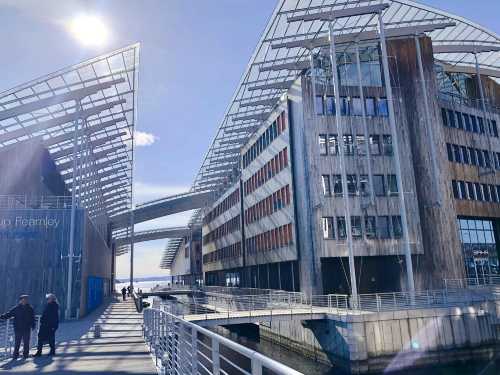Popular Trip Moments
Know This Before Visiting Oslo — Save Time & Money 🇳🇴✨ | The dream train journey | Travel around Europe with the Global Eurail Pass | Oslo, Norway in 2 days | 10 Must-Do Experiences in Norway! Complete These and Return as a Legend to Rave About! | 🚗 Ride-Sharing in Oslo: Explore Norway’s Capital Efficiently in One Day 🇳🇴✨ | Norway | Reverse Travel Guide to Norway | A Healing Escape for Introverts: The Ultimate Nordic Getaway Guide! | Norway: Immersing Myself in Munch at the Munch Museum! 🎨🇳🇴 | Oslo Day Trip|Art and Architecture | My 3 days in Oslo, Norway | Where Art Screams: Oslo’s Munch Museum🖼️ | Norway is incredibly beautiful, but I honestly don't recommend visiting in June because... | Free Museum Day at Oslo City Hall: A Cultural Gem in the Heart of the City | How to Spend Weekend in Oslo: Art, Architecture & Arctic Vibes 🇳🇴🕰 | Oslo in 1 day 🇳🇴 | A park showcasing masterpieces by a renowned sculptor | Norwegian Winter Aurora: Experience the Romance of the Northern Lights with Your Loved One | Must-share things to do in Oslo, Norway🇳🇴 | Norway in a Nutshell: A 4-Day, 3-Night DIY Trip | Spring Awakens in Oslo: Where Fjords Meet Art & Nature | A Day of Art in Oslo – Museums, Murals & Munch Cookies | A Chill Day in Oslo – Coffee, Culture & Sunset Strolls | 📌1.5 days to explore Oslo for free✅Tips on how to avoid pitfalls and save money | Vigeland Sculpture Park | Astrup Fearnley Museum of Modern Art | Oslo Opera House, Norway | Munch Museum, Norway | Viking Ship Museum, Oslo, Norway | [Norway🇳🇴] A route to enjoy a day in Oslo, a beautiful city with a calm atmosphere 🌲 | Oslo Frogner Park
Recommended Attractions at Popular Destinations
Attraction near Bangkok | Attraction near Manila | Attraction near Tokyo | Attraction near Taipei | Attraction near Hong Kong | Attraction near Seoul | Attraction near Kuala Lumpur | Attraction near Los Angeles | Attraction near Shanghai | Attraction near New York | Attraction near Shenzhen | Attraction near Osaka | Attraction near Singapore | Attraction near London | Attraction near Guangzhou | Attraction near San Francisco | Attraction near Beijing | Attraction near Macau | Attraction near Bali | Attraction near Jakarta | Attraction near Paris | Attraction near Ho Chi Minh City | Attraction near Istanbul | Attraction near Phuket | Attraction near Chicago | Attraction near Seattle | Attraction near Toronto | Attraction near Orlando | Attraction near Cebu | Attraction near Chiang Mai
Popular Attractions
The Roman Baths | Shanghai Expo Park | Beijing Happy Valley | Huangpu River Cruise(Shiliupu Pier) | Warner Bros. Studio Tour Tokyo - The Making of Harry Potter | Ih Juu Temple | Craters of the Moon | Tianfu Square | Chen Clan Ancestral Hall | The Star Ferry | Castle Howard | Skyline Rotorua | Huaqing Palace | Pantheon | Stonehenge | RapidKL Monorail | Pavilion of High Mountain and Flowing Water | Red Gate Palace | Puffing Billy Railway | Cuihua Mountain·Qinling Zhongnanshan Unesco Global Geopark | Nemuroshi Park Golf Ground | Schloss Buskow | Chiesa di Nostra Signora dell'Assunta | Ekowisata Cisantana | Heerder Historisch Museum "Villa Jacoba" | Jacu Park | Hanuman Temple | Laguna San Nicolás | Kerala Ayurveda | Oceane Cruises Mauritius
Popular Restaurants in Oslo
Sabi Omakase Oslo | Kaffistova | Maaemo | Kontrast | Theatercaféen | Restaurant Fjord | Ekeberg Restauranten | La Romantica | Lofoten Fiskerestaurant | Engebret Cafe | Stortorvets Gjæstgiveri | Cafe Skansen | Frognerseteren Restaurant | Dovrehallen | Celsius | Tasty Thai | Hos Thea | Grefsenkollen | Tjuvholmen Sjomagasin | Jensens Bofhus | Yummy House | The Salmon | Alex Sushi | Ruffino Ristorante Italiano | Aymara | Villa Paradiso | Elias Mat & Sant | Egon Byporten | Rorbua | Den Glade Gris
Popular Ranked Lists
Popular Premium Hotels Near Kolkata | Top 10 Local Restaurants in Qingyuan | Popular Must-Visit Restaurants in Taipei | Popular Best Things to Do in Jinchang | Popular Premium Hotels in Pandaan | Popular Must-Visit Restaurants in Kyoto | Popular Premium Hotels in Shan | Top 3 Best Things to Do in Fuding | Popular Premium Hotels Near South Arut | Popular Premium Hotels in Scarborough District | Popular Premium Hotels in Hinderwell | Popular Premium Hotels in Nikos Kazantzakis | Popular Premium Hotels Near Komet | Popular Must-Visit Restaurants in Tokyo | Popular Premium Hotels in Willersey | Popular Must-Visit Restaurants in Rome | Popular Premium Hotels in Durango | Popular Premium Hotels Near North Banjar Baru | Popular Premium Hotels in Durango | Popular Must-Visit Restaurants in Hanoi | Popular Premium Hotels in Karimabad | Popular Must-Visit Restaurants in Athens | Popular Premium Hotels in Mayminsky District | Popular Must-Visit Restaurants in London | Popular Best Things to Do in Libo | Popular Must-Visit Restaurants in Singapore | Popular Must-Visit Restaurants in Melbourne | Top 9 Best Things to Do in Sanming | Popular Best Things to Do in Heze | Popular Best Things to Do in Huangshi
Payment Methods
Our Partners
Copyright © 2025 Trip.com Travel Singapore Pte. Ltd. All rights reserved
Site Operator: Trip.com Travel Singapore Pte. Ltd.
Site Operator: Trip.com Travel Singapore Pte. Ltd.























